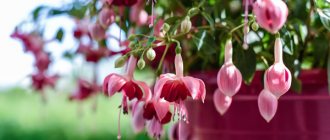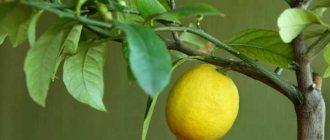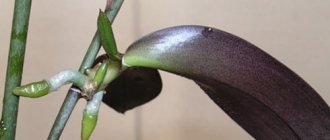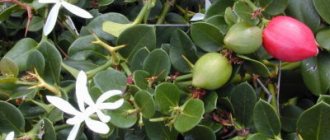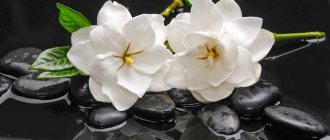How to properly form a plant
The plant is distinguished by interestingly shaped flowers that combine several shades. On each branch several thinner stems are formed, on each of which 3-10 inflorescences subsequently develop. The flowers have an outer row of strongly expanding pointed petals, several rows of rounded small petals and long stamens at the core. Each of these parts may be different from the others in color, blue, yellow, white, pink, red or purple.
Note! There is no single requirement on how to form a fuchsia bush correctly. The crown can have any shape depending on your own wishes.
Pruning is necessary to remove the weakest shoots that will bloom poorly. For example, you can immediately remove stems that are too long and thin or those that have only a couple of small leaves, while the rest are distinguished by an abundance of greenery. It is also necessary to trim stems that have become woody over time. Only the trunk of the bush cannot be trimmed.
Fuchsia
Features of the procedure: instruments, disinfection
The main tool is a knife or garden shears. It is very necessary to disinfect equipment before the procedure. This will prevent viral diseases that are transmitted through the juice of affected flowers.
For disinfection, various compositions containing alcohol are used. You can use medical sprays, alcohol wipes, or household products such as chlorine and kerosene.
Potassium sulfate disinfects well . Dip the instruments into the solution for a few minutes and then wipe with a clean cloth.
Fuchsia has faded: what to do next
Fuchsia seeds - cultivation
What to do with fuchsia after flowering? It is necessary to partially cut the stems, this will have a beneficial effect on subsequent flowering. It is better to prune twice: in early autumn and in mid-spring. First of all, wilted or shriveled stems are removed. After this, young shoots and branches at the ends should be trimmed. Next, the fuchsia is trimmed based on decorative preferences, that is, the desired crown shape is set.
Note! Fuchsia can easily curl around a support. It is often braided so that the stems grow in the right direction. Young stems can be intertwined with each other so that they form one low trunk of an interesting shape.
When pruning fuchsia in autumn, it is important to inspect the branches for the presence of harmful insects or diseases affecting the bark. If something like this is actually found, the diseased branch and its small healthy part will have to be removed.
Pruning Fuchsia
Step-by-step instruction
First, let's say a few words about the tools you will need to trim fuchsia. This could be a knife, garden shears, or pruning shears. Pre-disinfect the selected device to prevent the possibility of infecting plants with viruses, the strains of which may be on dirty instruments. This can be done by treating the blades with an alcohol-containing preparation, bleach, or kerosene. Just dip them in the solution and then wipe them with a clean rag.
in spring
It is worth clarifying that this does not mean calendar spring - for this plant it begins somewhere in mid-February. You will notice swelling of the buds, and this will be the first “bell” to pruning.
- Over the winter, indoor fuchsia grows a number of thin, frail shoots that will not produce flower stalks, so they should be removed first.
- Next, all dried, woody branches are cut off.
- Let's move to the center of the plant. We thin out the branches there so that the bush is not too thick.
- We correct the shape of the crown. We cut off the shoots, retreating 1.5-2 centimeters from the node.
- We evaluate the work done. If you notice a loose twig sticking out unattractively to the side, you can slightly pull it towards the trunk using thread or thin wire.
in autumn
You need to prepare in advance for autumn pruning. Around mid-September, stop feeding the plant with nitrogen supplements, leaving potassium and phosphorus. Reduce the single dose of water, water less often (in winter it is generally recommended to do this twice a month). If your “ballerina” stood on the balcony in the summer, then let it remain there until it gets colder (the minimum possible temperature is +5° C). This will help her smoothly enter hibernation.
Next, carry out antifungal treatment of fuchsia and inspect it for the presence of clutches of harmful insects. The fact is that over the winter the bush will weaken, and then it will be easier for the new “tenants” to destroy it by eating the young shoots.
Another distinctive feature of autumn pruning is the removal of green shoots. They are unlikely to survive the winter, so there is no point in leaving them.
So, step by step instructions:
- first you need to pick off all the dried leaves;
- remove all unripe, diseased, weakened and damaged shoots;
- trim branches that violate the shape of the crown, as well as those that are curved or simply unattractive;
- those shoots that remain will have to be shortened by a third;
- If you plan to send the fuchsia to the cellar for the winter, leave it at home for a while - the cut areas should dry out.
How to form fuchsia on a trunk: pruning scheme, recommendations
Diseases and pests of fuchsia
What to do next when the fuchsia has faded? After the fuchsia has faded, the faded cuttings and twigs that have formed above the young buds are removed.
The standard is formed from a healthy cutting with a strong, straight stem. When planting, it is necessary to install a stick to support the main trunk. Next, you need to figure out how to shape the planted fuchsia. To start forming fuchsia on a trunk, you first need to let it grow to the desired height, cutting off all the side shoots. When the stem reaches the desired height, the top is cut off, and immediately after this young side shoots begin to form. By pinching them, you can get a lush flowering bush.
Forming a fuchsia crown is easy; this way you can give it a certain shape. For example, you can give it the shape of a heart, a ball or a small tree, based on the calculation that from each cut piece two more will grow. They will be directed towards the angle at which the trim was made.
Fuchsia pruning scheme
Diseases
The plant very rarely gets sick. Diseases can occur as a result of improper care after pruning . The most common are:
- Rust . The disease can be recognized by the presence of brown spots on the inner surface of the leaf. This disease is fungal and can be introduced as a result of pruning if the tools used for the affected flower are not disinfected. It is urgent to remove the affected leaves and treat with Bordeaux mixture at intervals of 2-3 days.
- Root rot . This disease is formed as a result of improper hydration. A healthy plant has white and elastic roots. If during transplantation it turns out that the roots are dark brown in color, then this is root rot.
Pruning fuchsia is a necessary agrotechnical technique, without which the plant will not bloom actively and luxuriantly. This process is simple, so even a novice gardener can do it. But if this is not done, the plant will take an unattractive shape, the number of buds will decrease, as will their size.
If you find an error, please select a piece of text and press Ctrl+Enter.
Pinching and forming a fuchsia cutting
Why do fuchsia leaves wither and fall off?
You should not pinch the plant too often, at least you should be careful with this before flowering begins. Pinching involves cutting off young shoots and leaves. The ends of very thin branches that have recently formed are cut off, so the tree’s energy is not used to grow greenery that is useless this season, but to ensure that the flowers are large and bloom well. Thanks to pinching, crown growth slows down; it should be done about once every two weeks throughout the summer. Already in the fall, you can do a full crown pruning, without reducing the number of flowers on the bush. Fuchsia, pruned and pinched correctly, will bloom much more abundantly, more luxuriantly and a little longer.
Note! You need to know how to pinch fuchsia so that it produces as many flowers as possible. The main shoot needs to be cut at an angle, soon two more young ones will appear from it, do the same with them.
A correctly pruned bush is overgrown with many young shoots, at the end of each of which inflorescences form. Basically, it is on young shoots that buds are formed, that is, in order to get a profusely flowering bush, you need to cut off the maximum number of stems from which new ones will appear
Pinching and forming a fuchsia cutting
Pruning after flowering
After the bush has flowered, it is recommended to partially cut off the branches. This will allow the bush to gain strength. The procedure is carried out twice a year: in September and April. First, all wilted and dry stems are removed from the plant. The next step is for the gardener to cut off all the young shoots. Then the fuchsia is formed to the desired shape. The plant can wrap around supports. Therefore, the stems can be braided or intertwined with each other. In the fall, the gardener should inspect the fuchsia for the absence of pests and diseases. If detected, the diseased branch should be cut off, including the healthy part.
In order for a plant to bloom long and profusely, it needs to gain strength. For this, timely cutting is used. The later the fuchsia branches are pruned, the longer the plant takes to bloom. It is better to prune the bush in the fall and immediately after wintering. In the autumn months this is done as a preventative measure. Remove damaged, thin shoots from the bush.
Repeat the procedure from February to March. Manipulations with pruning shoots are necessary to form a beautiful plant crown. This is done so that there are buds at the ends of the branches. First, remove all weak branches. They are unlikely to bloom, and if they do, the flowering will be weak. After this, you need to cut off dry branches and thin shoots. Then comes the pruning of branches that are directed to the center of the bush. So, the bush will stop thickening and will bloom profusely.
Care after pruning
In order for the plant to be healthy and strong, it is important not only to prune it correctly, but also to provide care after the procedure. After the procedure, you should place the pot with the bush so that scattered sunlight falls on it. Windows facing the north or east side of the house are best. If the plant does not have enough light, the shoots will weaken and the flowers will be sparse and small.
It is important to choose the right watering mode. Water fuchsia moderately after pruning. It cannot be flooded, but the soil should not dry out. Watering is carried out with soft, settled water. In winter, the flower is watered twice a week, in spring once or twice a week.
After the fuchsia has overwintered, it is necessary to introduce fertilizing. Fertilize the bush from spring to autumn. To do this, you can purchase special formulations for flowering plants. Fuchsia should not be overfed. Otherwise, the bush quickly grows green mass, but blooms sparingly. Fuchsia devotes all its strength to the growth of leaves and shoots.
There is no need to feed the bush once every two weeks. The fertilizing composition should include magnesium and nitrogen. Compositions with potassium and phosphorus are also useful for fuchsia. Fertilizing is applied only to moist soil. Organic compounds are diluted so that the water concentration is twice as high as recommended in the instructions for use. Otherwise, the fuchsia will bloom worse and will quickly begin to grow upward.
In winter, gardeners recommend completely abandoning fertilizer. With the right approach, the plant quickly recovers after pruning and gains strength. After a couple of months, it begins to actively form buds and bloom with bright, unusual flowers. This plant will decorate a flower garden or home windowsill. Despite the fact that this is a heat-loving flower, it is grown in flower beds and in apartments.
Wintering fuchsia in open ground. Winter pruning rules
In most cases, gardeners are advised to dig up fuchsia for the winter and leave it in pots indoors or at home; fortunately, this is not so difficult to do. This will protect the tree from frost by keeping it warm. If the bushes have already reached quite large sizes or there are a lot of them on the site, it will not be possible to store them indoors. In this case, you can simply cover the plants with spruce branches or spunbond. They should survive the winter well. Some varieties need to be cut almost to ground level, covered generously on top, sometimes even sprinkled with 10-15 cm of soil. At the end of spring, the plants are dug up, after which they begin to grow again.
Note ! Annual varieties of fuchsia do not need to be left for the winter; instead, cuttings will have to be re-rooted every year.
Useful tips for gardeners on pruning and shaping fuchsia bushes
Many people are interested in how to prune fuchsia at home and whether it should be done at all. Pruning fuchsia at home should be done less often than when growing in open ground. A significant difference will be the size of the bush and the thickness of the stems. If in natural garden conditions you can get a bush-shaped tree 1.5 m high, then at home a small bush no more than 20-30 cm will grow.
Important! We need to figure out how to prune such a small fuchsia without cutting off excess stems. The pruning scheme is the same as for large bushes; young shoots are cut off by 1-2 cm so that several new ones grow in their place.
Growing fuchsia at home is a little easier due to the absence of the need to replant for the winter, and the temperature regime will not change so much throughout the year. And in summer, the scorching sun will not fall on the flower, whose rays often burn through the delicate leaves of fuchsia growing in its natural environment.
Plants that have miniature shapes and small leaf sizes, as well as the flowers themselves, require much less effort and can bloom much earlier than other varieties. They do not require as much care and will bloom even in not the hottest climates.
5 1 vote
Article rating
Season selection
So, from the above it is clear that pruning for fuchsia is a useful and necessary procedure. When is the best time to do it?
- Very often this is done in the spring, before new buds appear. If you prune according to the instructions, the fuchsia will delight you with bright and lush flowering.
- As for the autumn period, it is best to wait until the end of October - beginning of November. It is in the fall that it is recommended to prune the fuchsia contained in the apartment. The procedure consists of removing parts of the branches where the flowers were located, as well as shortening the shoots to the first pair of leaves with stone buds from the top.
- If you are the owner of one of the varieties of fuchsia that blooms until late autumn, you can prune it for the winter. However, most often bushes that are sent to spend the winter in the basement, cellar, or balcony (for example, were dug up from a flower bed) undergo such a “haircut.” It is recommended to shorten the branches, leaving them only 1/3 of their length (but not more than 15 cm).

